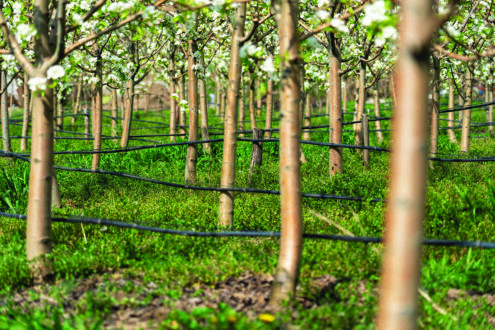

Apr 7, 2023Conserving water: Group defines Farm Bill irrigation needs
Conservation programs have long been a key part of farm bills over the years, and the 2023 Farm Bill will be no different.
The Specialty Crop Farm Bill Alliance (SCFBA) has established five core principles under which they’ve made 109 specific recommendations for members of Congress to consider in the farm bill:
- Healthy Americans.
- Competitiveness and sustainability.
- Trade and foreign competition.
- Research and innovation.
- Natural resources and climate.
The final principle addresses water conservation and sustainable irrigation needs.
“The production methods and structure of certain specialty crop producers have historically inhibited their ability to participate in many USDA conservation programs,” according to the SCFBA’s statement of principles. “Recognizing the diverse nature and unique challenges involved in specialty crop production enhances the ability of specialty crop producers to participate fully in all USDA conservation programs as well as any initiatives to address global climate change.”
Farm bill conservation tools include various Natural Resources Conservation Service (NRCS) programs, which traces its beginnings to 1935 — a response to the dust bowl that devastated American agriculture. Those include the Environmental Quality Incentives Program (EQIP) and Agricultural Management Assistance (AMA).
USDA describes EQIP as the NRCS’ “flagship conservation program” helping farmers and ranchers integrate conservation into work lands, and AMA helps producers manage financial risk through diversification, marketing or natural resource conservation practices.
Ian LeMay, president of the California Fresh Fruit Association (CFFA), Fresno, is a member of the SCFBA’s steering committee. The CFFA is a founding member of the alliance.
“Sustainable practices have been priorities for California and U.S. producers forever,” LeMay said, “and the farm bill has been a continuous help in leveraging those practices, and helping to identify new practices for each generation.”
SCFBA irrigation recommendations
The alliance’s policy recommendations for irrigation and water management in the Farm Bill include:
- NRCS Standards and Specifications for sustainable irrigation practices should allow for flexibility in meeting the standard to mitigate producers’ risk of having to pay 100% of the cost (for example, of an unsuccessful well-drilling project).
- Establish a pilot program allocating $10 million per year to states to supplement NRCS sustainable irrigation funding. (California and Tennessee have such programs that could serve as models.)
- Due to the excessive cost of sustainable irrigation, any practices implemented to address the resource concern of “Climate Change Induced Risk” should not count towards EQIP’s $450,000 producer cap per Farm Bill.
- NRCS sustainable irrigation practices implemented through AMA should be cost-shared at the maximum allowable rate to encourage climate change adaptation.
- NRCS should increase the annual per-practice cap allowable through the AMA program from $50,000 to $100,000.
- The SCFBA also requests that a “Mechanization and Automation Technology Deployment Program” be established exclusively for specialty crop growers through the USDA’s Agricultural Marketing Service. The program would offset tech investments for environmental sensors and other equipment, including for “enhanced precision irrigation.”
Sustainable irrigation technology advances
Although the alliance’s recommendations don’t define “sustainable irrigation” methods, two of the most popular systems are drip irrigation and microjet sprinklers. Drip irrigation is standard at many fruit and vegetable farms. LeMay said many fruit growers who are CFFA members have adopted drip irrigation systems in the past 10-15 years.
“Especially as the industry has rotated orchards out, and gone back with new plantings, you’ve definitely seen a number of entities update their planting agricultural practices, and they’ve updated their irrigation practices as well,” he said.
Beyond the actual drip tapes or microjet sprinklers, LeMay said irrigation equipment manufacturers have introduced a number of products and systems that conserve water.
“They (manufacturers) continue to make advancements in the efficiencies and in a lot of the monitoring systems that are associated with irrigation applications, with the soil moisture monitoring and ET (evapotranspiration) monitoring,” he said. “The reality is, agriculture now has technical applications beyond what a lot of people realize.”
The water situation in many California fruit and vegetable growing regions has changed dramatically since the alliance began planning for the 2023 Farm Bill, with rains and snow greatly reducing immediate concerns of the prolonged three-year drought cycle in many areas of the state.
“Although we are being blessed this winter with an abundant amount of rain and snow in the Sierras, water has continually been a scarce resource in this state, and the commodity sectors that our association represents are permanent fresh fruit varieties,” LeMay said. “One of the necessary components to maintain a viable tree or vine is water, and when that resource is scarce, like it has been in California, you want to maximize fertility the best you can.
“That’s where you’ve seen the industry move to those more efficient forms of irrigation, and you’ve seen them invest in the ability to track and monitor that application to make sure that each tree and each vine is maximizing that irrigation,” he said.














